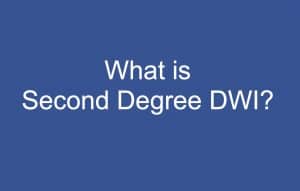What is Second Degree DWI in MN?
2nd Degree DWI is a gross misdemeanor in Minnesota. Gross misdemeanors have a maximum punishment of up to one year in jail and a $3,000 fine. 2nd Degree DWI is the second most severe level of DWI in Minnesota. 1st Degree Felony DWI is the only more serious DWI. Felony DWIs trigger when someone has four DWIs in a ten-year period or a prior felony DWI.
A driver can be charged with a 2nd Degree DWI in various ways. A first-time DWI can even be a 2nd Degree DWI in limited circumstances. Often this happens as a person’s second or third DWI offense in a ten-year period. There are aggravating factors in Minnesota that determine what level of degree of DWI is appropriate. One aggravating factor is if your evidentiary breath, blood, or urine test results in an alcohol concentration of .16 or more within two hours of driving. Another aggravating factor is if you had a child under the age of 16 in your vehicle at the time. A third aggravating factor is if you have a prior DUI conviction or driver’s license revocation arising from a DWI within the past ten years. If you have two or more of these aggravating factors present, then your DWI will become 2nd degree. Another way to get to that level is if you refuse the evidentiary test in your current DWI and you have a prior DWI conviction or license revocation within the past ten years.
The alcohol concentration level test that is important is the evidentiary test an officer asks you to take. This differs from the PBT. A PBT (preliminary breath test) is the test law enforcement asks people to take at the side of the road or near the location of arrest. Similarly, officers cannot charge you with a refusal DWI for refusing to take a PBT. Evidentiary tests are what law enforcement needs to charge someone with Refusal DWI.
2nd Degree DWIs also invoke mandatory minimum sentences for second or third DWIs in a ten-year period. A second DWI in ten years initiate more severe mandatory minimum sentences than a third DWI in ten years. However, avoiding mandatory minimum sentences depends on the particulars of your case, such as the prosecutor, judge, and defense attorney.
2nd Degree DWI arrests also frequently lead to someone being held in custody until bail is set and paid. The driver also may appear in front of a judge at an arraignment or first court appearance; or are released on conditions such as an alcohol monitor after their arrest. If the person is held in custody, they are likely going to be subjected to the mandatory maximum bail of $12,000. Judges will also give an alternative of lower bail or no bail plus the condition of someone being tested for alcohol consumption through an electronic-alcohol-monitoring device.
2nd Degree DWIs also initiate driver’s license revocations and license plate impoundment. 2nd Degree DWIs can also trigger seizure of a motor vehicle. Minnesota laws are frequently changing on vehicle forfeiture in the DWI context. Currently, you can get your vehicle back without having to challenge the matter in court in some situations. Other times, you can exercise your right to challenge your vehicle being taken away in court. Pay attention to the deadlines to file the challenge, otherwise you can lose your right to challenge the vehicle seizure.

